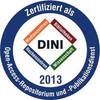German Title: Strukturelle und funktionelle Analyse des humanen tRNA-Ligase-Komplexes RTCB
PDF, English
- main document
 Restricted access: Repository staff only until 24 July 2026. Restricted access: Repository staff only until 24 July 2026.
Login+Download (8MB) | Terms of use |
Abstract
RTCB-type ligases are a relatively new discovered class of RNA ligases that ligate RNA substrates with 3′-P or 3′-cP and 5′-OH in an GTP and cation dependent manner. In metazoan, RTCB is an essential enzyme that ligates tRNA exons during splicing and is a key component of the IRE1 branch of the unfolded protein response. During the stress response, RTCB ligates the exon halves of the transcription factor XBP1’ mRNA. In humans, RTCB is the catalytic core of the pentameric tRNA ligase complex, consisting of the subunits DDX1, CGI-99, FAM98B and ASW. The function of each component and complex composition are unknown. In archaea and metazoan, RTCB-mediated ligation is dependent on the promoting factor Archease. The mechanism by which Archease enhances RTCB-mediated ligation remained unknown. HsArchease was found to interact with CCAR2, a protein acting in the mTOR pathway. The function and interaction between these two are thus far unknown. My research focuses on the human tRNA ligase RTCB, the tRNA ligase complex subunits and the promoting factor HsArchease. Here, I use biochemical assays to determine metal ion and nucleotide cofactor dependence on RNA ligation catalysis by HsRTCB in the context of HsArchease’s promoting effect. For the first step of ligation, HsRTCB guanylylation, the human ligase is fully dependent on HsArchease and the cofactors Mn2+ and GTP. Crystal structures of nucleotide-free HsRTCB, monomeric HsArchease and the pre- and post-activation complexes between HsRTCB and HsArchease provide mechanistic details of nucleotide exchange and HsArchease-mediated RTCB activation. In absence of the nucleotide cofactor, HsRTCB adopts an open conformation to enable nucleotide binding in the active site pocket. By formation of a composite three metal ion active site between HsRTCB and HsArchease, electron density shifts facilitate the nucleophilic attack from the HsRTCB active site histidine onto the α-phosphorus atom of GTP. While previous structures of Archease depict a dimeric conformation, the monomeric HsArchease structure as well as the two crystal structures of the pre- and post-activation complex provide evidence that the RTCB ligation promoting form of HsArchease is monomeric, with a conserved tip that fits into the active site pocket of HsRTCB. Furthermore, I purified the human tRNA ligase complex, single subunits and CCAR2 for structural analysis using Cryo-EM or x-ray crystallography. RNA ligation assays demonstrate the acceleration of HsRTCB-mediated ligation by DDX1. In summary, I present crystal structures representing different stages of the HsRTCB ligation cycle and provide mechanistic insights into the HsArchease-dependent activation reaction. Additionally, I structurally analyse the human tRNA ligase complex and the interplay between CCAR2 and HsArchease.
Translation of abstract (German)
RTCB Ligasen sind eine relativ neu entdeckte Klasse von RNA-Ligasen, die RNA-Substrate mit 3′-P oder 3′-cP und 5′-OH in einer GTP- und kationenabhängigen Weise ligieren. In Metazoen ist RTCB ein essentielles Enzym, das während des Spleißens tRNA-Exons ligiert und eine Schlüsselkomponente des IRE1-Zweigs der ungefalteten Proteinantwort (UPR) ist. Während der Stressantwort ligiert RTCB die Exon-Hälften der mRNA des Transkriptionsfaktors XBP1. Im Menschen bildet RTCB den katalytischen Kern des pentameren tRNA-Ligase-Komplexes, der aus den Untereinheiten DDX1, CGI-99, FAM98B und ASW besteht. Die Funktion jeder einzelnen Komponente sowie die genaue Zusammensetzung des Komplexes sind noch unbekannt. In Archaeen und Metazoen ist die RTCB-vermittelte Ligation von dem Aktivator Archease abhängig. Der Mechanismus, durch den Archease die RTCB-vermittelte Ligation verstärkt, war bislang unbekannt. Es wurde festgestellt, dass HsArchease mit CCAR2 interagiert, einem Protein, das in den mTOR-Signalweg involviert ist. Die Funktion dieser Interaktion ist bislang nicht geklärt. Meine Forschung konzentriert sich auf das humane tRNA-Ligase enzym RTCB, die Untereinheiten des tRNA-Ligase-Komplexes und den Aktivator HsArchease. Mithilfe biochemischer Assays untersuche ich die Abhängigkeit der von HsRTCB durchgeführten RNA-Ligation von Metallionen, Nukleotid-Kofaktoren und dem Aktivator HsArchease. Für den ersten Schritt der Ligation, die Guanylierung von HsRTCB, ist die humane Ligase vollständig auf HsArchease sowie die Kofaktoren Mn²⁺ und GTP angewiesen. Kristallstrukturen von nukleotidfreiem HsRTCB, monomerem HsArchease sowie den Prä- und Post-Aktivierungskomplexen zwischen HsRTCB und HsArchease liefern mechanistische Einblicke in den Nukleotidaustausch und die HsArchease-vermittelte Aktivierung von HsRTCB. In Abwesenheit des Nukleotid-Kofaktors nimmt HsRTCB eine offene Konformation an, um die Nukleotidbindung im aktiven Zentrum zu ermöglichen. Durch die Bildung eines zusammengesetzten dreifachen Metallionen-aktiven Zentrums zwischen HsRTCB und HsArchease führen Elektronendichteverschiebungen dazu, dass der nukleophile Angriff der Histidin-Seitenkette von HsRTCB auf das α-Phosphoratom von GTP erleichtert wird. Während frühere Strukturen von Archease eine dimerische Konformation zeigen, liefern die monomere HsArchease-Struktur sowie die beiden Kristallstrukturen des Prä- und Post-Aktivierungskomplexes Hinweise darauf, dass die RTCB aktivierende Form von HsArchease ein monomer ist, mit einer konservierten Spitze, die genau in die aktive Tasche von HsRTCB passt. Darüber hinaus habe ich den humanen tRNA-Ligase-Komplex und CCAR2 für strukturelle Analysen mittels Kryo-EM oder Röntgenkristallographie aufgereinigt. RNA-Ligation-Assays zeigen die Beschleunigung der HsRTCB-vermittelten Ligation durch DDX1. Zusammenfassend präsentiere ich Kristallstrukturen, die verschiedene Stadien des HsRTCB-Ligationszyklus darstellen und gebe Einblicke in die HsArchease-abhängige Aktivierungsreaktion. Zusätzlich analysiere ich strukturell den menschlichen tRNA-Ligase-Komplex und das Zusammenspiel zwischen CCAR2 und HsArchease.
| Document type: | Dissertation |
|---|---|
| Supervisor: | Peschek, Dr. Jirka |
| Place of Publication: | Heidelberg |
| Date of thesis defense: | 15 July 2025 |
| Date Deposited: | 29 Jul 2025 14:15 |
| Date: | 2026 |
| Faculties / Institutes: | The Faculty of Bio Sciences > Dean's Office of the Faculty of Bio Sciences |
| DDC-classification: | 500 Natural sciences and mathematics |
| Controlled Keywords: | Molekulare Biologie, Molekularbiologie, Strukturbiologie, Structural biology, Biochemie, Proteine, Enzyme, Ligation, RNS, Ribonukleinsäure, RNA |
| Uncontrolled Keywords: | RTCB, RTCB complex, DDX1, CGI-99, FAM98B, ASW, Ashwin, Archease, tRNA ligase |









